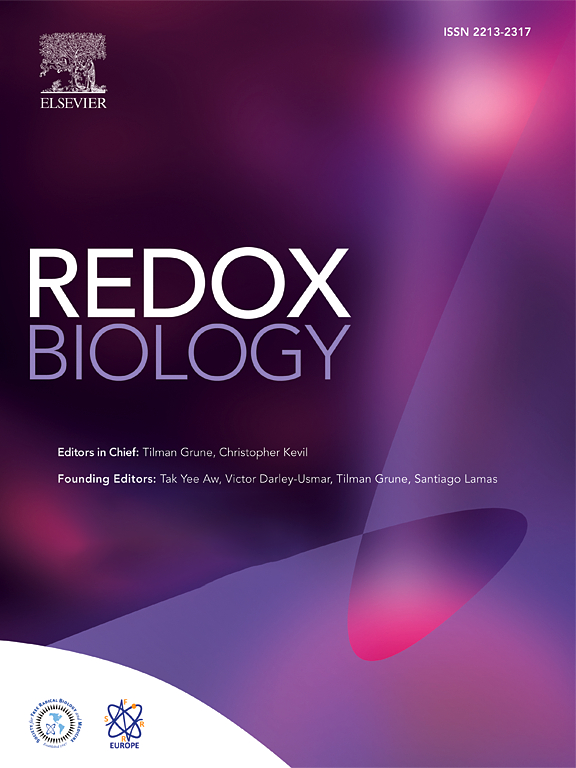Glucagon-like peptide-1 receptor signaling activation in alveolar type II cells enhances lung development in neonatal rats exposed to hyperoxia
IF 10.7
1区 生物学
Q1 BIOCHEMISTRY & MOLECULAR BIOLOGY
引用次数: 0
Abstract
Background
Many studies have reported the important role of glucagon-like peptide-1 receptor (GLP-1R) in regulating glucose homeostasis. However, in addition to the pancreas, GLP-1R is distributed in organs such as the lungs. A few researches have reported the mechanism of action of GLP-1R in acute and chronic lung diseases. Nevertheless, its effect on lung development remains unclear. In this research, we aimed to explore the role of GLP-1R in regulating lung development and its potential mechanisms in in vivo and in vitro bronchopulmonary dysplasia (BPD) models.
Methods
Neonatal Sprague-Dawley rats were divided into hyperoxia (FIO2 = 0.85) and control (FIO2 = 0.21) groups. Lung tissues were extracted at 3, 7, 10, and 14 postnatal days and subjected to hematoxylin and eosin staining for histopathological and morphological observation. Single-cell RNA sequencing was performed to explore the role of GLP-1R in lung development. Western blotting was conducted to assess the expression of GLP-1R, dynamin-related protein 1 (DRP1), and glycolysis-associated enzymes, including phosphofructokinase (PFKM), hexokinase 2 (HK2), and lactate dehydrogenase A (LDHA), in the lung tissues, primary alveolar type II (ATII) cells, and RLE-6TN cells. Double immunofluorescence staining was performed to confirm the co-localization of GLP-1R, DRP1, and ATII cells. A Seahorse XF96 metabolic extracellular flux analyzer was used to perform real-time analyses of extracellular acidification rate and oxygen consumption rate in ATII cells isolated from lung tissues and RLE-6TN cells. The adenosine triphosphate (ATP) concentrations in ATII and RLE-6TN cells were measured using an ATP kit. Mitochondria were stained with MitoTracker and observed using HiS-SIM. GLP-1R gene levels in lung tissues, primary ATII cells, and RLE-6TN cells were tested using RT-qPCR. We used MeRIP-qPCR to determine the m6A modification level of GLP-1R mRNA in RLE-6TN cells. A reporter gene was used to verify the modification site and key methyltransferases.
Results
We observed that GLP-1R signaling regulates lung development and plays a key role in ATII cells, particularly after birth. Hyperoxia inhibits GLP-1R protein and gene expression in ATII cells and accelerates BPD development. ATP production decreased and glycolysis levels increased in ATII cells under hyperoxia. Activation of GLP-1R signaling promotes ATP production and downregulates glycolysis by regulating DRP1 induced mitochondria fission. In RLE-6TN cells, we verified that the m6A modification level of GLP-1R mRNA decreased; the modification site was tested by MeRIP-qPCR and was primarily induced by the methyltransferase-like 14 (METTL14).
Conclusion
GLP-1R is primarily expressed in ATII cells of neonatal rats and can promote lung development during the early postnatal period. The GLP-1R signaling pathway modulates mitochondrial fission and glucose metabolism in ATII cells under hyperoxia. Hyperoxia can inhibit the activation of GLP-1R by inhibiting m6A methylation during BPD pathogenesis.
肺泡II型细胞中胰高血糖素样肽-1受体信号的激活促进了高氧新生大鼠的肺发育
许多研究报道了胰高血糖素样肽-1受体(GLP-1R)在调节葡萄糖稳态中的重要作用。然而,除了胰腺外,GLP-1R还分布在肺等器官中。一些研究报道了GLP-1R在急慢性肺部疾病中的作用机制。然而,它对肺部发育的影响尚不清楚。在本研究中,我们旨在探讨GLP-1R在体内和体外支气管肺发育不良(BPD)模型中调节肺发育的作用及其潜在机制。方法将Sprague-Dawley大鼠分为高氧组(FIO2 = 0.85)和对照组(FIO2 = 0.21)。分别于产后3、7、10、14天提取肺组织,苏木精和伊红染色进行组织病理学和形态学观察。单细胞RNA测序研究GLP-1R在肺发育中的作用。Western blotting检测GLP-1R、动力蛋白相关蛋白1 (DRP1)和糖酵解相关酶,包括磷酸果糖激酶(PFKM)、己糖激酶2 (HK2)、乳酸脱氢酶A (LDHA)在肺组织、原发性肺泡II型(ATII)细胞和RLE-6TN细胞中的表达。双免疫荧光染色证实GLP-1R、DRP1和ATII细胞共定位。采用Seahorse XF96代谢细胞外通量分析仪实时分析肺组织分离的ATII细胞和RLE-6TN细胞的细胞外酸化速率和耗氧量。采用ATP试剂盒检测ATII和RLE-6TN细胞的三磷酸腺苷(ATP)浓度。线粒体用MitoTracker染色,用HiS-SIM观察。采用RT-qPCR检测肺组织、原代ATII细胞和RLE-6TN细胞中GLP-1R基因水平。我们使用MeRIP-qPCR检测RLE-6TN细胞中GLP-1R mRNA的m6A修饰水平。一个报告基因被用来验证修饰位点和关键的甲基转移酶。结果我们观察到GLP-1R信号调节肺发育,并在ATII细胞中发挥关键作用,特别是在出生后。高氧抑制ATII细胞GLP-1R蛋白和基因表达,加速BPD的发展。高氧条件下,ATII细胞ATP生成减少,糖酵解水平升高。GLP-1R信号的激活通过调控DRP1诱导的线粒体裂变促进ATP的产生并下调糖酵解。在RLE-6TN细胞中,我们证实GLP-1R mRNA的m6A修饰水平下降;修饰位点经MeRIP-qPCR检测,主要由甲基转移酶样14 (METTL14)诱导。结论lp - 1r主要在新生大鼠的ATII细胞中表达,并能促进出生后早期肺的发育。GLP-1R信号通路在高氧条件下调节ATII细胞的线粒体分裂和葡萄糖代谢。在BPD发病过程中,高氧可通过抑制m6A甲基化来抑制GLP-1R的活化。
本文章由计算机程序翻译,如有差异,请以英文原文为准。
求助全文
约1分钟内获得全文
求助全文
来源期刊

Redox Biology
BIOCHEMISTRY & MOLECULAR BIOLOGY-
CiteScore
19.90
自引率
3.50%
发文量
318
审稿时长
25 days
期刊介绍:
Redox Biology is the official journal of the Society for Redox Biology and Medicine and the Society for Free Radical Research-Europe. It is also affiliated with the International Society for Free Radical Research (SFRRI). This journal serves as a platform for publishing pioneering research, innovative methods, and comprehensive review articles in the field of redox biology, encompassing both health and disease.
Redox Biology welcomes various forms of contributions, including research articles (short or full communications), methods, mini-reviews, and commentaries. Through its diverse range of published content, Redox Biology aims to foster advancements and insights in the understanding of redox biology and its implications.
 求助内容:
求助内容: 应助结果提醒方式:
应助结果提醒方式:


